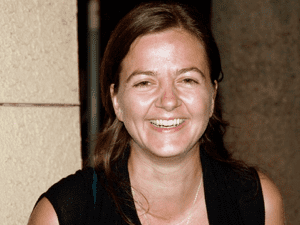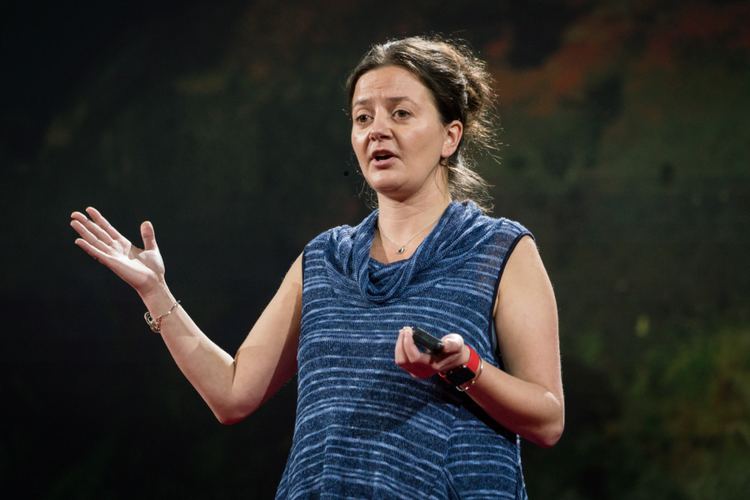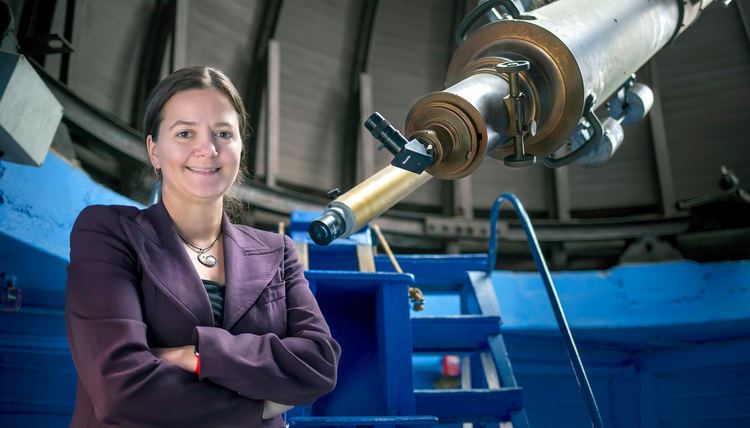Name Tabetha Boyajian | Role Astronomer | |
 | ||
Fields Exoplanetary astrophysicsStellar observationsHigh angular resolution astronomy Education B.Sc. 2003 College of CharlestonM.Sc. 2005 Georgia State UniversityPh.D. 2009 Georgia State University Thesis Sizing up the Stars (2009) Known for Discovery of strange light curve for KIC 8462852 | ||
Doctoral advisor Harold A. McAlister | ||
Tabetha Suzanne Boyajian (born c. 1980) is an American astronomer on faculty at Louisiana State University. She was a post-doctoral fellow 2012–16 at Yale University, working with Debra Fischer. Boyajian is active in the astronomical fields of stellar interferometry, stellar spectroscopy, exoplanet research, and high angular resolution astronomy, all particularly at optical and infrared wavelengths. She was the lead author of the September 2015 paper "Where's the Flux?", which investigated the highly unusual light curve of KIC 8462852; the star is colloquially known as Tabby's Star in her honor.
Contents

Background

Boyajian received a BS degree from the College of Charleston in 2003, an MS degree in Physics from Georgia State University in 2005, and a PhD degree from the same university in 2009. She studied the sizes of nearby stars similar to the Sun, using the University's CHARA array, a long-baseline optical and infrared interferometer located at Mount Wilson Observatory. Boyajian was awarded a Hubble Fellowship, and stayed at Georgia to study sizes of nearby stars much smaller than the Sun and stars with planets. Fellow astronomer Sarah Ballard has described this as "truly remarkable" work and has used what she calls this "precious sample" of data on nearby small stars for the "characterization by proxy" method to help investigate the far more distant exoplanet Kepler-61b.

Boyajian cowrote Extrasolar Planets and Their Host Stars in 2017 with Kaspar von Braun (von Braun & Boyajian 2017).

As of 2015, Boyajian is secretary and steering committee member of Division G Stars and Stellar Physics of the International Astronomical Union.
Boyajian is also manager of the Planet Hunters project in which amateurs analyze data from the Kepler space observatory.
Tabby's Star
On 14 October 2015, a strange pattern of light from star KIC 8462852, nicknamed "Tabby's Star" after Dr. Boyajian — the lead researcher who discovered the irregular light fluctuation— was captured by the Kepler Space Telescope, and raised speculation that a Dyson sphere may have been discovered. In February of 2016, Dr. Boyajian gave a TED (Conference) talk where she explained the story of how her research on the star quickly took a turn into the mysterious. However, she was skeptical and in the talk she reminded everyone that skepticism is the best policy whenever delving into alien territory. Her exact quote is as follows:
"Extraordinary claims require extraordinary evidence, and it is my job, my responsibility, as an Astronomer to remind people that alien hypotheses should always be a last resort."
Wanting to rationalize the strange light pattern, Dr. Boyajian put several hypotheses to the test. Everyone's first thought was an exoplanet detected around this massive star, but the dips in light lasted anywhere from 5 to 80 days and were erratically spaced apart thus ruling out any kind of an orbit for one celestial object. A dust cloud was proposed but the star showed no signs of being young so a dust cloud was highly improbable. Lastly, a comet shower was hypothesized. However as Dr. Boyajian pointed out in her TED (Conference) this was the most likely out of all the hypotheses and yet was stil highly improbable. "It would take hundreds of comets to reproduce what we're observing. And these are only the comets that happen to pass between us and the star. And so in reality, we're talking thousands to tens of thousands of comets."
So after all the natural explanations turned up weak, her team decided to send off their research to SETI (Search for extraterrestrial life) to rule out aliens. After reviewing the research the SETI Institute was so intrigued that they decided to study the star themselves and pointed their Allen Telescope Array (ATA) at the star "with hopes of catching a tell-tale signal that might reveal a technological civilization."
The SETI Institute mentioned what caught their eye and made them take on the research themselves: "Even more interesting, the timing of the present dip (in light) suggests that whatever this material is, it is situated at just the right distance from the star to be in the "habitable zone," where we believe life like ours could develop as it has on Earth."
Being as skeptical as Dr. Boyajian was, she took SETI's approach and allowed herself to have a bit of fun in hypothesizing what the light pattern could have been. In her Ted Talk she joked: "Another idea that's one of my personal favorites is that we had just witnessed an interplanetary space battle and the catastrophic destruction of a planet. Now, I admit that this would produce a lot of dust that we don't observe. But if we're already invoking aliens in this explanation, then who is to say they didn't efficiently clean up all this mess for recycling purposes?" The search for answers to KIC 8462852 is still on going.
